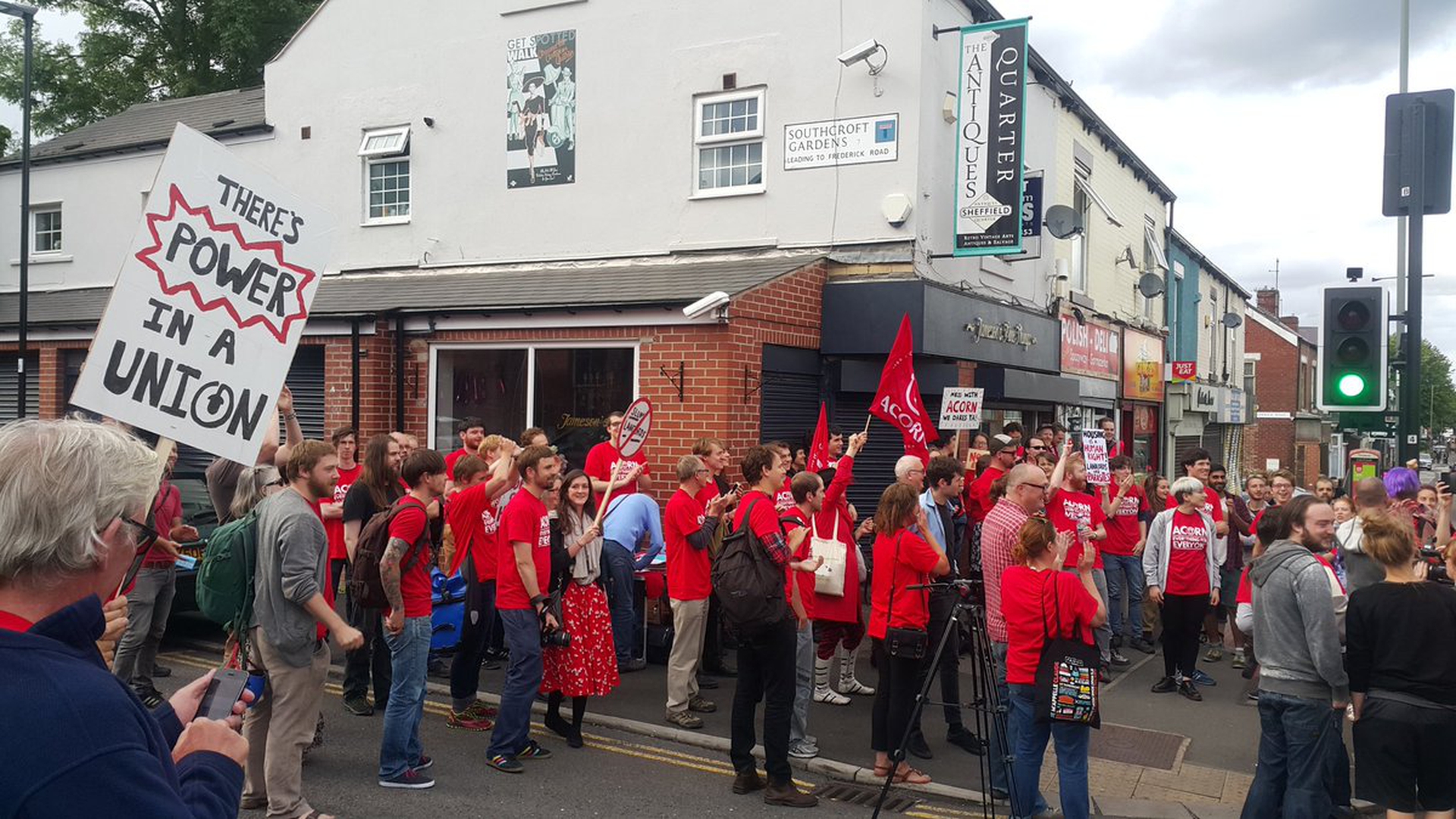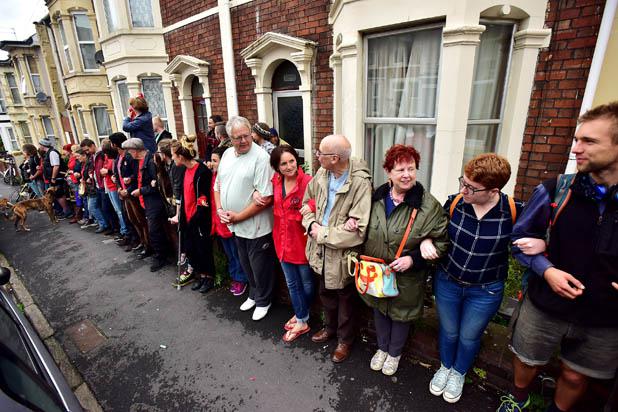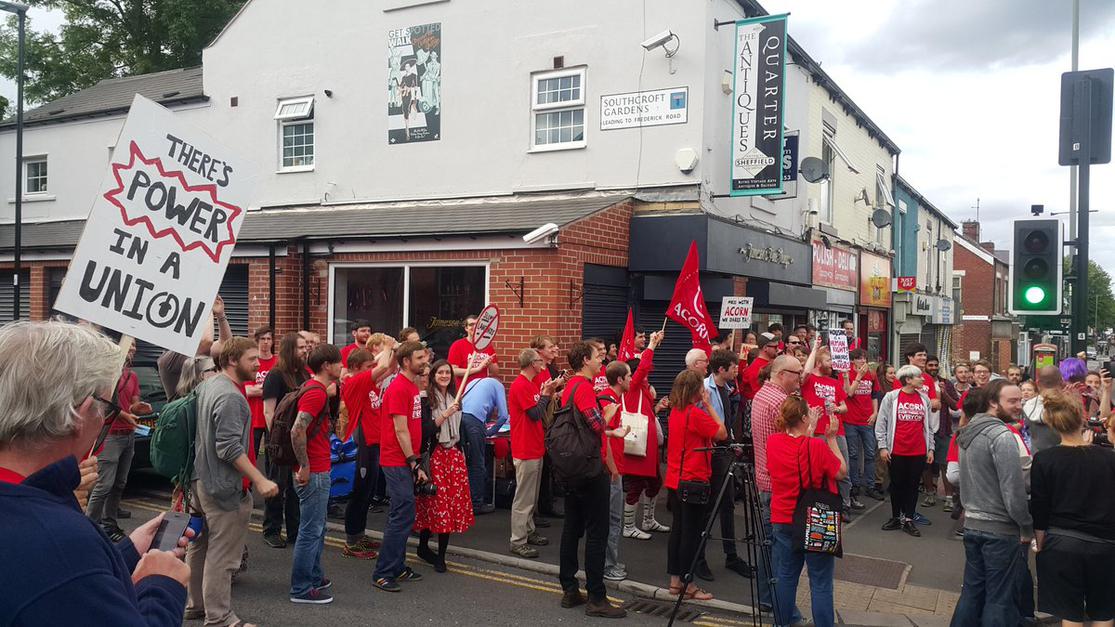Taking What’s Ours: an ACORN Inquiry
by
Callum Cant (@CallumCant1)
August 16, 2018
Featured in The Worker and The Union (#3)
How community syndicalism is building the base for a mass socialist movement

inquiry
Taking What’s Ours: an ACORN Inquiry
by
Callum Cant
/
Aug. 16, 2018
in
The Worker and The Union
(#3)
How community syndicalism is building the base for a mass socialist movement
Since 2017, renters’ unions have grown rapidly. As the housing situation in UK cities goes from bad to worse, fighting organisations have developed to challenge the power of landlords, letting agents and councils. Their model of ‘community syndicalism’ has managed to get a grip on the everyday experience of renters.
ACORN, the largest UK renters’ union, provides the best example of how this process of self-organisation has taken place. Through a history of the national union, its local Brighton branch, and one specific eviction resistance campaign, we can see both the big picture and the day to day detail of what’s happening on the ground. Neighbourhood by neighbourhood, in the middle of a crisis, these unions are one small example of how organising is the most direct route to class power.
A Short History of ACORN
ACORN is the child of the Lib-Dem/Conservative coalition government. However strange that may sound, it is accurate. The funding used to launch the project came, in part, from David Cameron’s ‘big society’ initiative. Three organisers, who’d cut their teeth in the syndicalist union the Industrial Workers of the World (IWW), used that money to cover their expenses, quit their jobs and begin setting up the union in late 2013.
The guiding idea behind ACORN was to go back to basics. It would be a community union that built its base through simple and patiently-applied organising strategies. At first, the organisers would knock on doors and chat about the problems people faced. Then, they’d build a direct action organisation to provide solutions. This work was going to be done in almost complete isolation from ‘the left’, which they saw as stuck in a cycle of desperate attempts to resuscitate the social movements of 2010-11.
The union began its first organising drive in the Easton neighbourhood of Bristol in early 2014. These first conversations on the doorstep led to one clear conclusion: the predominant issue people wanted to fight over was housing. This early period of ‘community inquiry’ gave the organisers the experience and information they needed to begin planning just what community syndicalism would look like in practice.
Four years of consistent hard work later, the outlines of that initial idea of community syndicalism can be seen much more clearly. ACORN Bristol now has a base of over 500 dues-paying members. They each contribute roughly an hour of their wages per month (on average, around £8). The city is split into three branches along postcode lines, with more local branches in the process of being established. The activity of ACORN can be split roughly into three parts: outreach, member defence, and campaigns.

Outreach is the basic activity of the union. It means going into the community, chatting to people, and building the union through one-on-one organising conversations. This outreach has two functions. First, it is a form of community inquiry that reveals what the local issues are, how things lie on the ground, what the power relations are and so on. The social composition of a neighbourhood only becomes clear through this basic research, conducted by the union with renters. Second, it allows the union to identify ‘organic leaders’ and potential members in an area who can be recruited. This process of identification is the first step towards building the organisation required to do something about the problems that have been pinpointed through community inquiry.
Member defence is how members look out for each others’ interests. Given the focus on housing in the union, this most often means getting repairs done, winning back a deposit, resisting an eviction or running a rent strike - but might also extend to dealing with wage theft or discrimination. These problems are confronted head on with mass community direct action. Member defence is really where the union earns its reputation for kicking ass for the working class.
Campaigns are the most outward facing part of ACORN’s activity. For the union, campaigning means taking on a big issue, forming coalitions and trying to win significant reforms. The objectives set by the union are deliberately winnable: the goal is to initiate a constantly escalating cycle of victories which build the union every step of the way. In Bristol, the paradigmatic example of campaigning model was a successful fight to resist the Labour council’s attempt to roll back council tax exemptions for 16,000 of the city’s poorest households. Nationally, big campaign focuses have been on eliminating the price-gouging clauses written into the buy-to-let mortgage contracts of banks like Santander and TSB; getting renters registered to vote; and forcing councils, housing associations and letting agents to guarantee that no-one would be evicted as a result of the transition to Universal Credit.
This model shares a lot of superficial similarities with de-politicised third-sector ‘community organising’. However, the fundamental difference of community syndicalism comes from its orientation towards a political method. ACORN prioritizes confrontational and direct tactics which put power into the hands of members on the streets, rather than making backroom deals with local ‘influencers’. ACORN has a few core slogans, but the two most popular are ‘Everything for Everyone’ and ‘Taking What’s Ours’. The goal of NGO-style community organising is ‘community empowerment’, whilst the goal of community syndicalism is class power. Fundamentally, the aim of ‘empowerment’ is to make working class communities into one of many political actors: to give them a new seat at an old table. The aim of class power, however, is to flip over the table.
This methodology has been highly effective. ACORN branches have now spread to Newcastle, Sheffield, Brighton, Manchester and Birmingham. These new branches are quickly growing and becoming self-sustaining. ACORN also has formal connections to sister union Living Rent in Scotland, and more informal connections to the London Renters’ Union. Community syndicalism has also galvanized a layer of highly-politicised organisers, many coming out of the social movement left, and begun to connect them into a national, combative, democratic union.
A Short History of ACORN Brighton
ACORN Brighton was first suggested in September 2017, four years after ACORN was first founded. A number of factors coincided to lead to the development of the branch.
First, the housing problem in the city kept on getting worse, with rents in the city rising by over 20% since 2014 and over 4,000 people left homeless. This escalating crisis had previously led to waves of organising around housing issues, but none of those efforts had been able to establish a durable mass participation model. Second, a ‘Cut the Rent’ group at Sussex university attempting to operate on the #RentStrike model had run up against the limits of student organising and recently failed to convert months of work into a strike. Third, the Grenfell tower fire had placed housing at the centre of the national political agenda. Pressure was building from multiple sources, but no one had yet found the right model that could convert that pressure into results.
Then, the newly-established Sheffield Branch of ACORN mobilised over a hundred people to prevent an eviction. It looked like a model worth trying. Two people met with a national ACORN organiser to investigate feasibility, and shortly after the branch-to-be had its first meeting of five friends in a small kitchen. In the beginning it was a union heavily connected to the University of Sussex. All of the five initial members were either students or support/teaching staff at the university.
ACORN full-timers came to Brighton and held a training day. The goal was to pass on the basic ACORN organising playbook. For almost everyone there, despite having been involved in political groups before, this was the first time they got taught a properly systematic organising approach. The twenty attendees at that training would be the organisers who’d push the union forward through a four-month organising drive before the official launch.During this drive, what seemed like a side project turned into a significant early victory.

Brighton’s student population is huge. They make up about 15% of the city’s total population, and as a result play an important role in the city’s housing market. Student numbers at the city’s two universities have risen from 25,000 in 1996 to 35,000 in 2016, and this increase took place without any appropriate investment in housing. As a result, on-campus accommodation has become full and highly expensive. Rents at the University of Sussex have risen consistently. The East Slope block used to go for £88.56 per week, but was then demolished and replaced by a ‘new’ East Slope, with rents rising to £156.55 per week. In the city, the number of Houses of Multiple Occupation (HMOs) has sharply increased as landlords break up run-down family homes into flats, which they then rent to students at premium rents. The average price for a single room in Brighton in the fourth quarter of 2017 was £558, up from £380 in the fourth quarter of 2010.
Eventually this pressure led to houses in multiple occupation (HMOs) being more tightly licensed by the council in order to slow the upwards pressure on rents. In a belated response, the University of Sussex has begun to buy property in the city to rapidly convert into university-managed accommodation. Predictably, conditions in some of these halls were bad, whilst rents were very high. ACORN Brighton was contacted by a group of dissatisfied students who wanted to improve the conditions of their Kings Hall block. After a relatively low-key organising effort, 30 of the 126 students in the block were prepared to launch a rent strike.

Just four days after the students voted to strike, the university were ready to cave. ACORN negotiated a settlement worth £515 per student, totalling c.£64,000. But the Kings Road strike didn’t generate a viable base. The student rent strikers had failed to take on the organising burden of their campaign, didn’t participate in branch meetings or support other tenants, and very few became dues-paying members of the union. The strike had proven the concept of a renters’ union and given the new branch a media profile, but didn’t result in lasting organisational gains. On the same day as the rent strike victory, the union won a deposit-return case against MyLets, a small agency in Hove, for a private renter. This direction would prove more sustainable in the long-term.
By this point the branch had began to develop very close links to the local Corbyn-supporting wing of the Labour party. Even though the wider union maintains party-political neutrality, the local branch had strong connections to the party. For some members ACORN was understood as part of a strategy to develop ‘Corbynism from Below’.
The branch began regularly sending speakers to Labour party ward and branch meetings, and counted among its supporters a number of councillors and Momentum local committee members. The Kings Rd. rent strike was openly supported by the newly-elected East Brighton, MP Lloyd Russell-Moyle.
The formal launch of the union in February 2018 drew over 100 people. Together, the attendees decided to push forwards with a campaign over universal credit. The campaign won some quick successes, with agreements made not to evict universal credit recipients due to late payment won from the council, housing associations and even a large private letting agent. Small-scale member defence activity led primarily by the branch committee also continued, winning victories like the return of part of a deposit to a night-shift worker. This was the state of play at the start of April 2018, after seven months. The union had around 50 dues-paying members and was starting to become more deeply established beyond the bubble of the city-based ‘left’.

A Short History of ACORN Brighton’s Biggest Win Yet
Wilkinsons letting agents is a small, local, family-run business with an office on one of the main roads in the east of the city, Elm Grove. Elm Grove is a steep mile-long hill which rises from the Level park, past a huge Catholic church to the Brighton General Hospital. The General Hospital is the old workhouse, built at the highest point in the city to tower over the vagrants below. Elm Grove forms northern edge of Hanover, a historically working-class area on the side of a steep hill made up of terraced housing and tower blocks built following slum clearances. The area is split roughly 50/50 between owners and private or social renters, with a significant number of student HMOs.
Brighton workers earn wages below the national average and pay increasingly expensive rents, leading to a growing mismatch. As a result, private renters in the area are often spending 40%+ of their after-tax income on low-quality housing. A shabby room without outward-facing windows in a five-person converted-garage flat goes for £500 a month. Letting agents often specify they won’t accept tenants claiming housing benefit, meaning that any renters’ who do find a landlord that will accept housing benefit also have to accept poor conditions. Renters in Hannover tend to work in jobs which reflect the local economy. They work in public services, in support or admin at the two universities, at the big American Express offices, in retail, in hospitality or at supermarkets.
Beverly Bishop, a single mum, was a long-term Hannover resident. She rented a property on Albion Hill from Wilkinsons just a few streets up from where her parents grew up. Over the years she’d rented the house it had progressively deteriorated as a result of damp. The mould was making her daughter ill, and she had been given medical advice that something had to change. So, she plucked up the courage to ask for repairs to be made. She’d recently gone off a rolling monthly contract back onto a fixed-term 12 month contract, paying higher rent, so she thought she was secure in her home. But she wasn’t. Wilkinsons soon served her a section 21 no-fault eviction notice, asking her to leave the property in June. They denied that her 12-month contract existed at all.
Beverly posted in a Facebook group called the Hanover Community Notice Board, explaining the situation. It was a large and well-used group that acted a social media hub for the local community. ACORN members on the group commented on the thread, offering to help. They met with Beverly soon after, discussed her situation, and agreed that if she joined as a member the union would fight her case.
The campaign began with a letter delivery on the 25th of April. The branch wrote to Wilkinsons, explaining their demands and giving them a timeframe for response. The goal was to successfully prevent the eviction without having to get anywhere near the eviction date itself, in order to give the Bishop family as much security as possible. The campaign would end when a new 12-month contract and a commitment to make damp-proofing repairs had been won. The situation seemed so clear cut that a quick victory was expected. Wilkinsons, union members assumed, were relying on Bev not causing a fuss. If she objected, with the support of the union, then victory would be pretty swift. It always had been before. But this assumption would prove very wrong.
Wilkinsons ignored the letter, and a demonstration was called for the next Saturday. This demo was ACORN’s biggest yet, drawing a crowd of about eighty. But Wilkinsons still didn’t respond, and the branch had to move onto calling a daily picket outside their offices. During the second of these daily pickets, Ian Wilkinson came outside and agreed to a meeting to negotiate and resolve the dispute in a couple of days time. The agency went to the Argus, the local newspaper, and made a lot of noise about how they were resolving the dispute. ACORN called off the pickets and prepared to negotiate a victory. It had taken more effort than expected, but the campaign had still been quite brief.
But emails attempting to arrange the meeting went unanswered. Ian Wilkinson seemed to have suddenly changed his mind. The daily pickets were back on, and another demonstration was called for the next Saturday. Local councillors visited the picket lines to express their support and try and force Wilkinsons to negotiate, but now the letting agents were digging their heels in. They began to issue legal threats left, right and centre. Every new leaflet or social media post was being ‘passed onto our legal team’. The implication was that the union would be sued for slander for publicising the facts of the case.
At the same time as they upped the threats, Wilkinsons also began to concede that the eviction would not take place. They were willing, out of the goodness of their hearts, to withdraw the section 21 eviction notice and honor a 6-month fixed term contract. They wanted to put the union under pressure and simultaneously offer a way out, carrot and stick style.
But Beverly maintained she had signed a 12-month contract. The campaign wouldn’t end until that was won. Another demonstration came and went, and then another. The campaign was clearly now beginning to exhaust both sides. Wilkinsons grew more desperate, and began to call the police whenever ACORN visited their office, alleging that union members were harassing staff. The logic of private property showed itself in all its glory: throwing a family onto the street was entirely legitimate, but organising with other renters to complain about it? That was beyond the pale.
The police proved themselves quite willing to act as the letting agents’ bully boys, and issued ACORN with an informal warning under section 241 of the Trade Union and Labour Relations (Consolidation) Act 1992. They suggested that effective picketing which challenged the operation of the letting agent amounted to illegal intimidation. Fortunately, the police didn’t follow through on their threats. They did, however, start guarding the lettings agents whenever ACORN was about.
But this attempt to use the police to break the union was Wilkinsons last throw of the dice. When it didn’t work, they were exhausted. At a 9am meeting on Tuesday 5th June the landlord and letting agent agreed to give the Bishop family a fully backdated 12-month contract and to make all repairs recommended by the council’s environmental health department. The letting agent and landlord had deliberately held on for dear life in an attempt to break the union. But rather than breaking ACORN, they had just handed the union its biggest victory yet.
During the campaign renters were being recruited on the picket line, as the union branch’s dues-paying membership and wider layer of supporters both expanded substantially. The day negotiations ended, a mopping-up phase was already being planned. The goal of this phase was to communicate to the community that the campaign had been won through collective action. Hopefully a month or so of hard work at an opportune time could result in a deep-organising base being established in Hanover. 3,000 copies of a leaflet publicising the victory have since been distributed. The branch now has over 80 dues-paying members.
Rank-and-file recomposition
In their essay ‘Without Reserves’, Salar Mohandesi and Emma Teitleman argue that the history of the American working class movement in the 1930s shows that an analysis of social reproduction 1 is vital to understand historical processes of recomposition:
But social reproduction was not just a terrain of struggle; it rapidly emerged as a site of class recomposition. Through struggles over social reproduction - over food, housing, and relief - different sectors of the American working class began to articulate themselves into a broader class unity. […] Although the process was uneven and fraught with contradictions, social reproduction nevertheless became a primary site of class formation during one of the most militant moments in American history. It was in neighbourhoods, apartments buildings, parks, schools and streets that the working class made itself into a political subject. 2
This process is not just consigned to history. The housing crisis in Los Angeles today is producing a similar dynamic. L.A. is partially comparable, at a different scale, with the situation in Brighton. In L.A. as in Brighton an above-average proportion of renters spend an above-average proportion of their income on rapidly-rising rents, whilst homelessness spirals out of control. The figures are striking: 54% of L.A. residents are renters and 57% of them spend over 30% of their income on rent; neighbourhoods like Boyle Heights are seeing as much as 80% rent increases year-on-year; and the homeless population has increased 40% since 2010 to over 53,000 people. In this context, rent strikes have become a prominent tactic. There have been at least six strikes in L.A. in the last two years, largely organised via the L.A. Tenants Union.
The conclusions drawn by Mohandesi and Titleman in the U.S. historically can also function as provocation from which to start a process of (co)research into the role of housing in a wider process of working class recomposition in US and the UK today. Unions like ACORN now face a challenge: to begin to produce a political subject, the ‘renter’, which can play a role in the ongoing regeneration of mass socialist organisation.
Renters in cities as widespread as Leeds, Liverpool, Hull, Derby, Nottingham, Southampton and Norwich are contacting ACORN looking to set up new branches. With a serious increase in resources, the union would have the momentum and capacity to establish 15-20 branches over the coming years. Many of these branches would be set up in cities without an existing ‘left’ ecosystem. ACORN has the potential to lead a process of green field organising in places where the political options currently available are reactionary nationalism or a passive Labour vote.

ACORN’s national membership spread
Socialists in the UK aren’t always organisers. That is a problem. We need every socialist to be an organiser, and every socialist to be committed to building unions, fighting organisations and infrastructure - both in the workplace and in the community. ACORN is one small demonstration of how that process can happen in practice. Street by street, estate by estate, block by block, renter’s unions are building the base we’ve been missing.
Additional data collection, Ellie Ferguson
-
Social reproduction and social composition share the same turf. The conceptual distinction between the two only results from the way in which they function within wider theoretical models. ↩
-
p.52 Mohandesi, S and Teitelman, E (2017). ‘Without Reserves’ in Social Reproduction Theory ed. Bhattacharya, T. Pluto Press: London. ↩
Featured in The Worker and The Union (#3)
author
Callum Cant (@CallumCant1)
Subscribe to Notes from Below
Subscribe now to Notes from Below, and get our print issues sent to your front door three times a year. For every subscriber, we’re also able to print a load of free copies to hand out in workplaces, neighbourhoods, prisons and picket lines. Can you subscribe now and support us in spreading Marxist ideas in the workplace?


